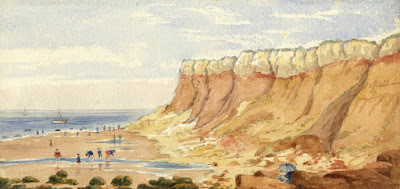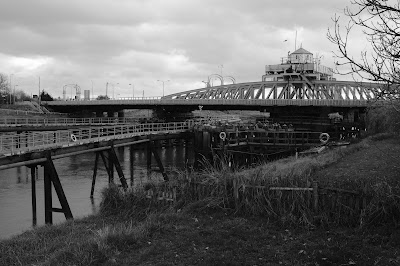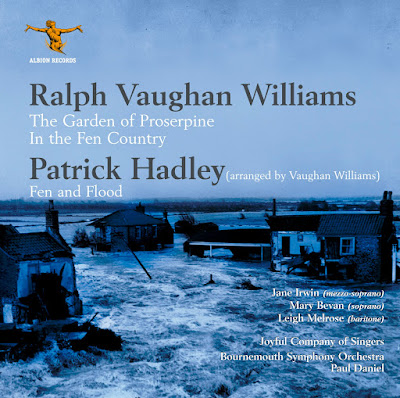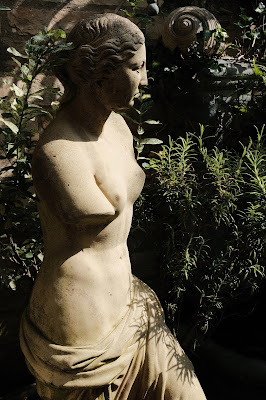 |
| Mary C. Durst, Bathing at Hunstanton Cliffs, Norfolk, 1888 |
READINGS
Isaiah 26.4
Trust in the Lord for ever,
for in the Lord God
you have an everlasting rock.
Isaiah 44.8
Do not fear, or be afraid;
have I not told you from of old and declared it?
You are my witnesses!
Is there any god besides me?
There is no other rock; I know not one.
Isaiah 51:1
Listen to me, you that pursue righteousness,
you that seek the Lord.
Look to the rock from which you were hewn,
and to the quarry from which you were dug.
IF ANYTHING WILL LEVEL WITH YOU WATER WILL
by A. R. Ammons
Streams shed out of mountains in a white rust
(such the abomination of height)
slow then into upland basins or high marsh
and slowing drop loose composed figurations
on big river bottoms
or give the first upward turn from plains:
that’s for modern streams: if sediment’s
lithified it
may have to be considered ancient, the result
of a pressing, perhaps lengthy, induration:
old streams from which the water’s
vanished are interesting, I mean that
kind of tale,
water, like spirit, jostling hard stuff around
to make speech into one of its realest expressions:
water certainly is interesting (as is spirit) and
small rock, a glacial silt, just as much so:
but most pleasurable (magma & migma) is
rock itself in a bound slurp or spill
or overthrust into very recent times:
there waterlike stone, those heated seekings &
goings, cools to exact concentration, I
mean the telling is unmediated:
the present allows the reading of much
old material: but none of it need be read:
it says itself (and
said itself) so to speak perfectly in itself.
—o0o—
ADDRESS
If anything will level with you water will—a meditation on flows, folds and fields, the material conditions of nature as she appears
 |
| The very golden sandstone Golden Lion Hotel in Hunstanton |
The last couple of weeks has seen the news full of stories connected with widespread flooding that affected many parts of England. At the same time there also came news of the serious floods in Venice, a city which, sooner rather than later, seems destined to disappear into the Adriatic and memory. At an obvious level these events remind us that, if anything will level with us, water will.
As these events were unfolding Susanna and I, in the company of an old college friend, Graham Driver, were travelling northwards for a week’s break to the North Norfolk coast, a shoreline which has itself always been seriously affected by flood and, of course, tide. It is on that coast, at Hunstanton — where we stopped for a splendid cup of tea at the Golden Lion Hotel — that you will find the continually eroding and quite beautiful and unforgettable multi-coloured cliffs formed of sedimentary rocks, principally sandstone and chalk the formation of which we will turn to in a moment.
 |
| Sutton Bridge taken on our journey up to the coast |
But, before arriving at this coast we took a circuitous diversion which took us deep into the watery, flood-prone landscape of the fens around Wisbech, Denver and Sutton Bridge. This fenland landscape was memorably used as the setting for Dorothy L. Sayer’s 1934 masterpiece, her Lord Peter Wimsey detective story called the ‘Nine Tailors’ which, as some of you will know, dramatically concludes during a serious flood of the fens, one which presaged the truly catastrophic North Sea floods of 1953 the memory of which remains vividly alive for many people on the eastern coast of Britain.
 |
| Fen & Flood CD cover |
In short, water and the threat of flooding were very much to the forefront of my imagination during our week away and so, perhaps not surprisingly, one evening before going to sleep I felt compelled to re-listen to Patrick Hadley’s cantata of 1955 called ‘Fen and Flood’. Hadley (1899-1973) was the Professor of Music here at Cambridge University between 1946 to 1962 and the text for his cantata was written with his friend Charles Cudworth (1908–1977), the musicologist, teacher and critic who was Librarian at the Cambridge University Music Faculty. ‘Fen and Flood’ was premiered at Gonville and Caius College, Cambridge on 12 June 1955 and one of the pianists in the first performance, Brian Trowell, wrote that:
It was particularly fitting that the premiere should have taken place in Gonville and Caius; the College has strong ties with East Anglia and many Caius men, indeed, went out with the emergency teams who fought the very floods that Fen and Flood so tellingly portrays.
It seems worthy of note that at its second performance at the Kings Lynn Festival on 27 June 1956 one of the soloists was a certain Fred Calvert, the Kings Lynn Superintendent of Police who had directed operations in the 1953 floods. The words he sung were those he used during the actual emergency rescue work.
But, merely left as I have just presented them to you, these things provide little more than a few interesting, and even entertaining, bits of information.
It wasn’t until a chance reading last week of the poem by A. R. Ammons you heard earlier that suddenly these water-related events suddenly began to speak with a voice that might, just possibly, be saying something relevant to us as people gathered together in a modern, free-thinking, religious and philosophical context.
To begin to hear this voice you need to be aware of two related hopes that have been very influential upon humankind, especially in its liberal Protestant and Enlightenment inspired forms.
The first hope was that in religion we should all — in principle — be able to encounter and love god or nature without ‘mediator or veil’, i.e. individually and directly without the need for priests and highly obscure (and obscuring) dogmas and rites.
The second, related, hope was that, if and when we encountered god or nature directly, it would deliver to us a message that was clear and transparent and which required no further interpretation from any one to understand it.
However, as even the most cursory study of history will reveal, all appeals to god or the gods have resulted in countless interpretations about what, exactly, was their message to us. Sticking to floods, for one person they are heard as a clear and transparent message from god or the gods about the need to be punished for some religious sin such as abandoning worship of the one true god; for another person the floods are a clear and transparent message aimed at punishing us for sexual immorality, treason against national or cultural identity, or countless other sins and high crimes and misdemeanours. For yet another person they are about all these things and much more.
Setting aside the countless problematic arguments about whether god or the gods do, or don’t exist, it’s helpful to return to the Greeks and the Romans here and recall that for them the messenger of the gods was Hermes/Mercury. As many of you will already know, we derive the modern word ‘hermeneutics’, which refers to the theory and methodology of interpretation, from the name ‘Hermes’.
In addition to his role as the messenger of the gods Hermes was believed to be the inventor of language and speech, an interpreter, a liar, a thief and a trickster and, together, these roles made him the perfect representative figure for hermeneutics. The point here is simple: were god or the gods to exist their messages are always going to be brought to us by some Hermes-like means that assures us any message will never, ever, be given in a clear and transparent way but always given slant; in these days we might say the message is always ‘seriously spun’!. In short between us and any god and gods who may or may not exist there will always be a mediator or veil, namely, interpretation.
Because our appeals to a supernatural god and the gods for a clear and transparent message about how to live in this world seem doomed it is no surprise there came to exist another hope that perhaps an appeal to a less fickle and more reliable nature might fare better.
For a long while this looked like being a very hopeful line of enquiry, certainly a more hopeful one than appealing to god or the gods for guidance about how to live in this world. But the truth is that we have never been able to find anything like a secure relationship between what is natural and what is (or isn’t) morally good. To our disappointment, Hermes seems to be as present as a mediator or veil between us and nature as he was between us and the gods. Once again, even the most cursory study of history teaches us that appeals to what one finds in nature have been used to support social Darwinism, the subjugation of women, arguments for and against slavery, homosexuality, egalitarianism, the idea of universal human rights and many other things besides. Interpretation, In other words, interpretation, continued to be required because nature, like god or the gods, does not give us any clear and transparent messages about how to live well in this world.
But, you may ask, what has all this to do with floods and Ammons’ poem?
Well, I think Ammons makes a slightly different and more successful, if extremely modest, appeal to nature which, although it doesn’t entirely do away with the need for troublesome Hermes, might, just now and then, afford us a fleeting and useful glimpse behind his veil which offers us the closest thing we can have to an unmediated encounter with nature, namely a reasonably secure sense of the basic material conditions for nature as she appears (cf. Lucretius’s phrase ‘naturae species ratioque’, De Rerum Natura 1.148, 2.61, 3.93, 6.41).
As is often the case with Ammons (who is sometimes described as being a twentieth-century Lucretius) he invites us to consider natural flows, folds and fields of matter as fundamental. In such a philosophy, everything is always-already in motion, even that which appears to us to be solid, stable and eternal, such as rock. Indeed, in this Lucretian inspired view, even the god of Isaiah — his rock of salvation and the rock and quarry from whence he thought he and all people were hewn and dug — would be something material made of these same natural, eternally moving, flows, folds and fields of matter.
Although modern, sub-atomic physics seems to be confirming this view of the world as being in constant motion, because it provides us this information in highly technical, complex and abstract ways it’s hard for most of us, including me of course, properly to grasp. Ammons, however, chooses to teach us the same lesson through the very tangible and visible example of sedimentary rocks.
Ammons starts us on our journey at the top of a waterfall and has us follow the water down into upland basins or high marsh and thence into big river bottoms which, in time silt up and begin to form plains. This, he tells us is ‘for modern streams’. But ‘if sediment’s lithified’ — i.e. turned to stone — through lengthy, kneading (magma), mixture (migma) and compression, these ‘old streams from which the water’s vanished’ are still interesting to us because the flowing, folding and fielding nature of water remains visible. As Ammons notes here, ‘water, like spirit, jostling hard stuff around’ has succeeded in making its speech ‘into one of its realest expressions’. In the form of these sedimentary rocks we see the flow, fold and fielding of water as if it were freeze-framed. We still see the in the apparently ‘solid’ rock, ‘slurp or spill or overthrust’, we still see the ‘waterlike’ quality of stone, its ‘heated seekings & going’. The cliffs at Hunstanton eloquently and beautifully bespeak of this.
Then, suddenly, Ammons tells us that, for him, this ‘telling is unmediated: the present allows the reading of much old material’ but, he adds, none of it need be read: it says itself (and said itself) so to speak perfectly in itself.’
But the question is, of what does it speak ‘perfectly in itself’ and in an unmediated way?
Well, it is simply and only of itself, by itself — i.e. as flow, fold and field of matter told by material flow, fold and field. To me, at least, standing before the cliffs at Hunstanton this voice is audible.
But what the water/rock does not — cannot — tell us in any unmediated, clear and transparent way, is how we must/need/should respond morally to the water/rock’s unmediated telling about the fundamental flows, folds and fields that are the material for conditions of nature as she appears.
It is at this point though that Hermes’ veil always descends once again and we are forced to interpret ourselves what it is that this unmediated-telling (or as near as unmediated as it is possible to get) means we think we should, ourselves be doing in response to this glimpse behind the veil.
At the very least, however, as Lucretius hoped two millennia ago, this message about natural flows, folds and fields given to us by natural flows, folds and fields can serve to help free us from thinking that behind the scenes — behind Hermes’ veil — god or the gods are actively seeking morally to direct or judge us in this or that fashion.
They do not and so, never again, need we fear the actions of a fickle supernatural god or gods.
Given this, the only ‘moral’ I can see that we might be able to take from all of the foregoing is the need always to be alerting all people — but especially our children — to the existence of these primordial, fundamental material flows, folds and fields so we can all begin consciously to live in wholly unsuperstitious ways.
And the minimal, practical, ethical/moral hope springing from this — and Hermes’ veil has already returned at this point — is that this minimalist, naturalistic message will help us to develop considerably less hubristic, anthropocentric and destructive ways of being in the world that work with these flows, folds and fields rather than against them (though in truth, of course, they can never be worked against).
Having gone via my circuitous, pedetic, flowing, folding and fielding thoughts had last week in the fens and on the Norfolk coast, I can return now to Isaiah with whose words I began this meditation.
It seems to me that, if in a liberal religious, free-thinking community like this, we are going to continue to use the language of god or the gods then it really should be a language which explicitly speaks, not of a god who is perceived to be some kind of static, immutable, ‘everlasting rock’ or quarry from which we are hewn or dug but, instead, a language which speaks in terms of a creative, material mother (mater) who through her everlasting, ultimately undivided, yet always moving flows, folds and fields of matter (materia) is constantly, and miraculously, weaving and unweaving all things. Maternalization is materialization
 |
| Venus in my back yard in Cambridge |
[In the giving of my address this morning I chose not to add the following short paragraph (taken from my Mothering Sunday address given earlier this year) because it seemed too personal, too confessional . . .]
In short that’s why, personally, when pushed to speak of god I have in mind only Venus, the mother of creation as poetically understood by the Roman poet Lucretius. As Thomas Nail reminds us, for Lucretius, Venus, ‘the mother of all creation is herself made of the same matter that she creates. Her materiality is the same materiality of the world. The mother of matter is the matter of the mother. Her creation is, therefore, the process of matter’s own process of materialization. Maternalization is materialization (Nail, Thomas, Lucretius 1: An ontology of motion, Edinburgh University Press, 2018, pp. 24).
How we then interpret what this insight might mean for us in our daily lives — well, that’s another matter entirely.